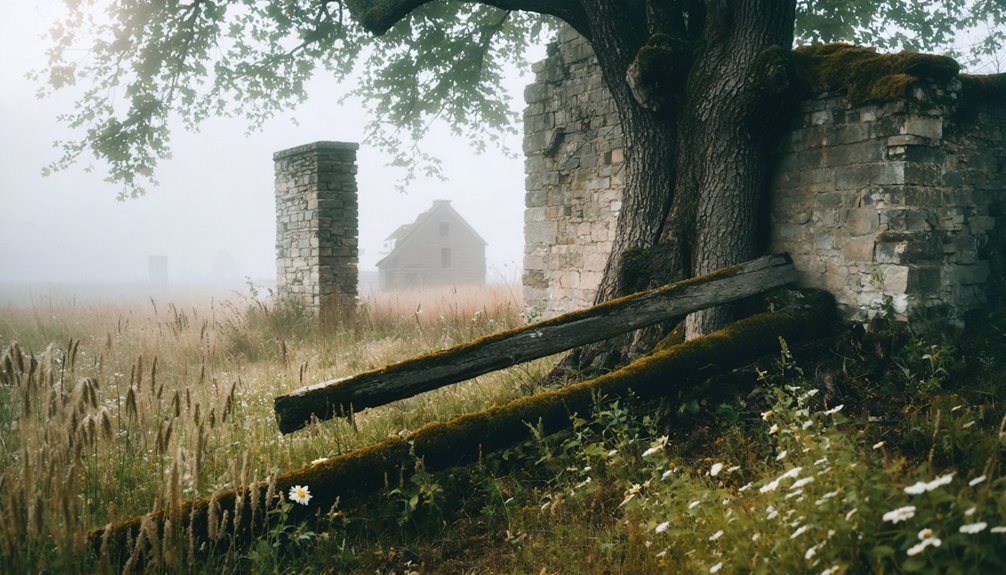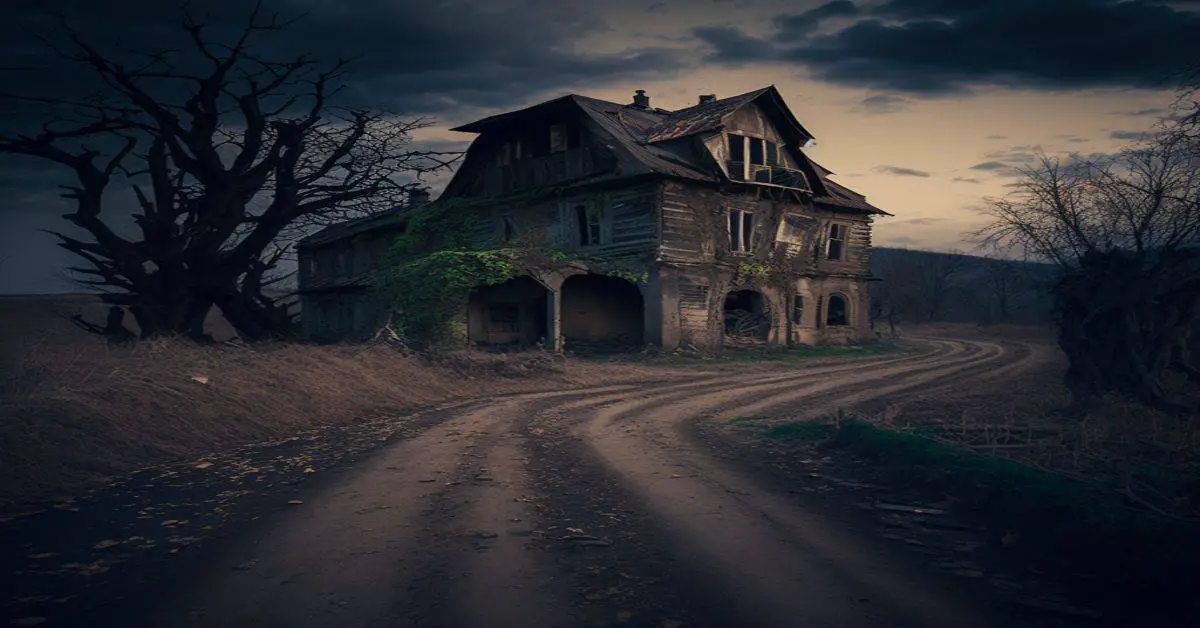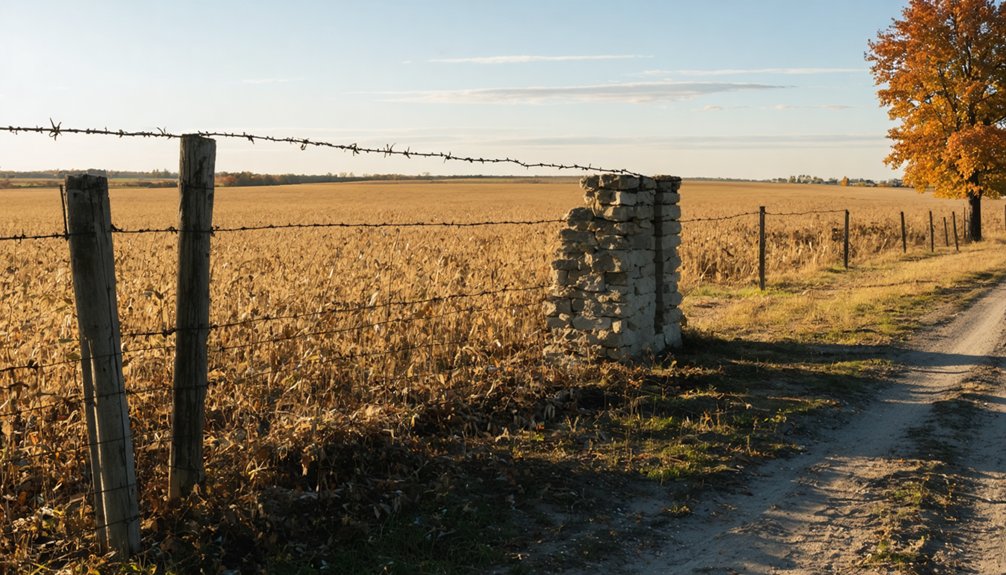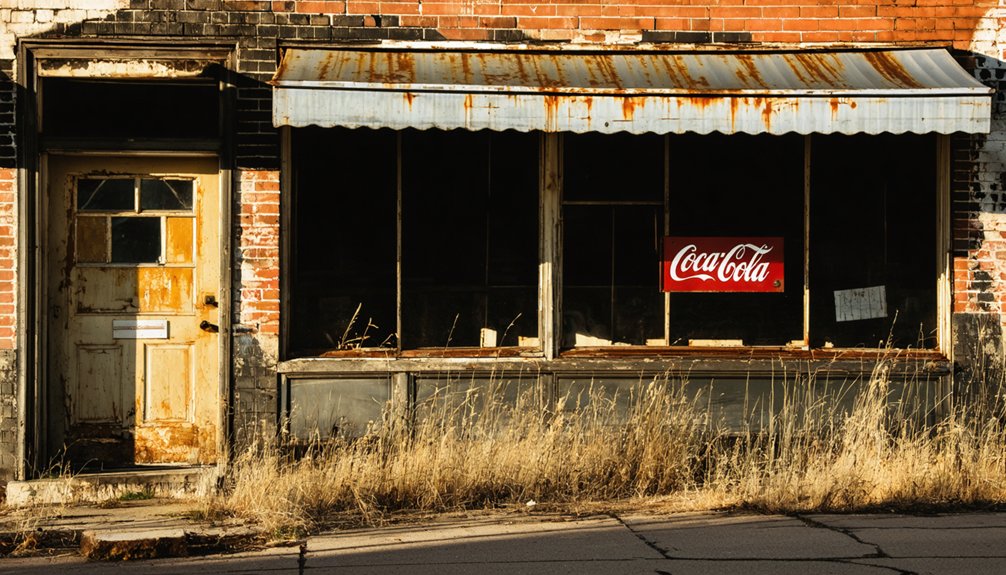You’ll find White Oak Springs, established in 1838, in Buckhorn Township of Brown County, Illinois, northeast of Benville and north-northwest of Morrelville. This frontier farming settlement struggled with transportation limitations, soil erosion, and economic isolation before its decline in the 1840s. Today, no original structures remain in this ghost town, though its geographical coordinates mark where pioneers like Smith Denman once built their community. The site’s history reveals fascinating patterns of frontier settlement and decline.
Key Takeaways
- White Oak Springs was established in 1838 in Buckhorn Township, Brown County, Illinois, as a frontier farming community.
- The settlement declined due to transportation limitations, lack of rail lines, and poor road conditions that isolated the community.
- Environmental factors like deforestation, soil erosion, and drought contributed to the town’s abandonment in the late 1800s.
- No original structures remain today, with the site returning to its natural state in modern Buckhorn Township.
- The ghost town represents a typical pattern of frontier community decline, preserved mainly through historical records and cultural memory.
The Early Settlement Years (1829-1838)
While settlements were emerging across Illinois in the late 1820s, White Oak Springs wouldn’t establish itself until 1838 in Buckhorn Township, Brown County.
During this period, settlement patterns followed the availability of land and resources, with pioneers like Smith Denman and Thomas Dixon establishing communities such as White Oak Grove as early as 1829.
Pioneer settlers sought promising lands, following resources and opportunities as they founded new communities across Illinois’s frontier landscape.
White Oak Springs emerged northeast of Benville and north-northwest of Morrelville, strategically positioned for trade and communication. Large numbers of Indians along the Mackinaw River between 1823-1829 influenced the settlement patterns of the region.
Arthur Martin, a blacksmith, played a pivotal role in the community’s development by founding the post office and establishing multiple businesses. The enterprising pioneer operated three local businesses including a blacksmith shop, general store, and copper shop.
While specific agricultural practices of the early settlers aren’t well documented, the region’s natural resources and proximity to other settlements suggest that farming and local commerce were central to the community’s economy.
Life in a Frontier Farming Community
As settlers established themselves in White Oak Springs during the late 1830s, they faced the characteristic challenges of frontier farming in central Illinois. You’d find these pioneers working together, breaking through the thick prairie sod with newly invented steel plows, transforming the tallgrass landscape into productive farmland. The promise of acquiring land at government prices of $1.25 per acre drew many hopeful farmers to the region.
Community dynamics centered around shared resources, with families settling near the area’s streams and woodland edges for essential access to water and timber. Disease outbreaks from contaminated creek water posed serious health risks to the early settlers.
Agricultural innovations quickly shaped life in White Oak Springs. You’d see wheat fields stretching across the rich black soil, while livestock grazed nearby.
Farmers adapted to the damp prairie conditions, building drainage systems and sharing labor during harvest times. The community’s survival depended on these collaborative efforts, with families gathering at the local church and schoolhouse to strengthen their social bonds.
Transportation and Economic Challenges
Despite its early promise as a farming settlement, White Oak Springs suffered from severe transportation limitations that ultimately stunted its economic growth. You would’ve found no rail lines connecting the town to larger markets, and the poor road conditions made moving goods nearly impossible.
Unlike other Illinois communities that built plank roads, White Oak Springs remained dependent on primitive local routes and trails. Some nearby towns flourished by constructing toll-funded roads that generated revenue for maintenance and improvements.
While nearby towns modernized with plank roads, White Oak Springs languished with its basic dirt paths and pioneer trails.
This economic isolation took its toll. You couldn’t easily sell crops beyond local markets, and job opportunities remained scarce without industrial development. The town’s trading potential had already been demonstrated when David Bovyer established his trading post there in October 1849.
As railroads expanded across Illinois but bypassed the town, younger residents left for better-connected areas. The population steadily declined as White Oak Springs’ transportation challenges made it increasingly difficult to sustain a thriving agricultural community in an era when market access became essential for survival.
The Slow Decline of White Oak Springs
Once transportation challenges took hold in the 1840s, White Oak Springs’ decline accelerated through multiple environmental pressures.
The settlement’s namesake white oak forests, which had drawn early settlers seeking timber resources, faced mounting environmental degradation that mirrored the town’s own fate.
You can trace the area’s deterioration through these key developments:
- Settlers cleared 93% of original forest cover by the 1830s for farming and grazing.
- Severe soil erosion forced constant field abandonment and new clearing.
- Fragmentation reduced oak habitats to isolated patches under 2 acres.
- Climate change and disease struck mature white oaks, killing 80-150 year old trees.
The pattern followed surveys showing that chronic stress factors like drought, flooding, and insect damage were devastating local oak populations. The environmental collapse paralleled the town’s economic descent, as both the white oaks and White Oak Springs proved unable to sustain their former vitality. Recent studies show that remaining white oaks in the region are dying at a rate of two to three trees per acre in affected areas.
What Remains Today: A Historical Legacy
While White Oak Springs once bustled with the activity of Arthur Martin’s general store and copper shop, today you’ll find little evidence of the 1838 settlement at its original location in Buckhorn Township.
Standing at 39°53′00″N 90°49′02″W, you’re surrounded by rolling Illinois hills where a post office and small trading community once thrived.
Unlike some of Illinois’ 82 ghost towns that maintain visible ruins, White Oak Springs’ historical significance lies mainly in archived records and cultural memory.
Though time erases physical traces of abandoned settlements, their stories endure through historical records and collective remembrance.
Similar to Buda, Illinois which became a living ghost town with only a few businesses remaining, White Oak Springs represents the gradual decline of once-thriving frontier communities.
You won’t discover preserved structures or monuments marking this remote outpost’s existence.
The site represents a common pattern in American frontier history – a small settlement that gradually faded into obscurity without dramatic circumstances or catastrophic events.
The land has returned to its natural state, leaving only geographical coordinates to mark its place in history.
Like the town of Wanboro, which was established in 1819 as a model community for English, White Oak Springs represents another example of frontier settlement ambitions that ultimately faded away.
Frequently Asked Questions
Were Any Notable Murders or Crimes Reported in White Oak Springs?
You won’t find any documented unsolved mysteries or historical crimes in the records. While early township boundary disputes caused tensions in the 1870s, no murders or major criminal activity were ever reported.
What Natural Disasters or Epidemics Affected White Oak Springs During Its Existence?
You won’t find records of major disease outbreaks or weather events affecting the settlement specifically. While the region faced typical 19th-century risks, no documented natural disasters directly impacted this location.
Did Any Native American Tribes Have Settlements Near White Oak Springs?
You’ll find that Native American tribes, particularly the Illinois Confederation and later the Kickapoo, controlled this area until 1819, though no permanent settlements were documented directly at White Oak Springs.
What Were the Most Common Surnames of Families in White Oak Springs?
Like scattered leaves in autumn winds, you’ll find limited family legacies documented, with “Martin” being the only verifiable surname through Arthur Martin’s postmaster and blacksmith roles during historical migrations to the settlement.
Was There Ever a Cemetery Established in White Oak Springs?
You can’t confirm if a cemetery existed since there aren’t any cemetery records or burial customs documented. While rural Illinois settlements often had informal burial grounds, no evidence supports one in White Oak Springs.
References
- https://illinoisstateonline.com/ghost-towns-in-illinois/
- https://www.youtube.com/watch?v=gM3ZIgtFzBk
- https://accessgenealogy.com/illinois/history-of-white-oak-illinois.htm
- https://en.wikipedia.org/wiki/White_Oak_Springs
- https://drloihjournal.blogspot.com/p/lost-towns-of-illinois-series.html
- https://whiteoaktownship.com/history/
- https://storymaps.arcgis.com/stories/043201d4267e4a66b44e7922832df7a2
- http://livinghistoryofillinois.com/pdf_files/Village of White Oak Springs
- https://accessgenealogy.com/illinois/early-settlers-of-white-oak-illinois.htm
- https://libsysdigi.library.illinois.edu/oca/Books2008-05/historyofeffingh00perr/historyofeffingh00perr.pdf



